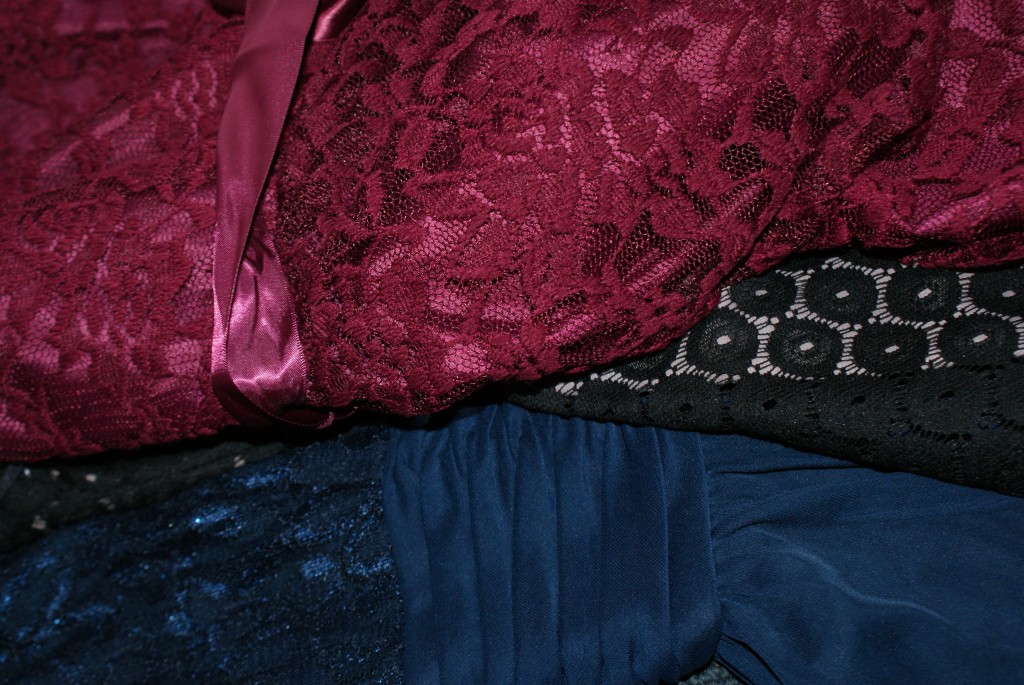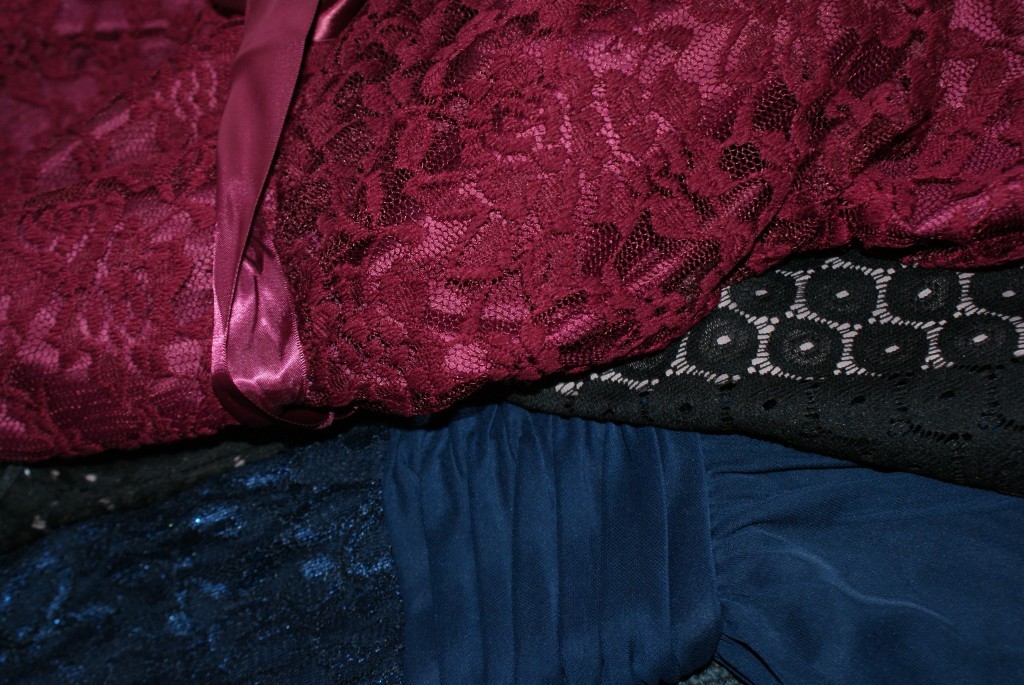I’m leaning against the clearance rack when Justin Timberlake’s voice fills the store. He’s singing about his suit and tie, which seems appropriate since my daughter is in the fitting room trying on semi-formal dresses.
As I lean, I look at the space below the fitting room door and see her feet—bandaids on the heels thanks to the chafing of those darn flats—standing on an island of discarded yoga pants and t-shirt. Timberlake croons “…can I show you a few things?” and my girl’s feet move and turn. The choreography that’s happening inside the fitting room tells a story. First, her toes face the mirror. She’s staring at herself, full-on, for a long time. Then her feet change directions; she’s looking at the back of the dress, craning her neck over her shoulder. Back and forth, her feet move, as she assesses the dress. A minute later, she stands still, and then her hand appears in the space above the door as it takes the hanger off a hook.
Because she took a heap of dresses into the fitting room, this dance continues for some time.
My daughter is fourteen, and the upcoming “ball” is the first major dress-up event of her high school career. Always a reserved, low-key kid, she teemed with excitement when she told me about the dance, asking first if it we had anything planned for that night, and if not, could she please go? Beyond that, she wondered if we could go shopping for a dress—nothing too fancy but something kind of fancy? She didn’t think she’d need new shoes or jewelry or anything. Maybe just a comfortable dress, perhaps a little sparkly?
This is the girl who fell into a lake when she was four, getting stuck between a pontoon boat and the dock. Never uttering a peep, she just stood silently in water up to her chest as the pontoon buffeted her against the wood and metal of the dock. When, later, I learned about this event, I felt sick to my stomach at the possibilities of that scenario and told her, “Oh, sweetie, you have to make noise. I know you’re a quiet person, but sometimes in life, when it really matters, you have to push beyond your natural tendencies, and you have to raise your voice. You have to make people notice you. Please, please, please, if there is any hint of danger, for the rest of your life, shout, yell, scream, thump—but make some noise.”
Her response was a placid, “I knew eventually someone would see me.”
She is unflappable, this girl—the rock around which the water flows. Thus, when she talks about a high school dance with excitement flickering in her eyes, I listen.
Yes, of course we could go dress shopping. It would, in fact, be a pleasure. Partially, the pleasure would come from watching my daughter transform into someone she has longed to be: a high school girl who gets to go to a big-time dance with a group of her friends. For years, she’s seen this scenario in movies, television shows, and books; now, finally, it would be her turn to take a twirl as the starring character.
On another level, watching my daughter try on dresses would help repair some lingering wounds from my own years in high school, a time when I never felt pretty or wanted or popular. Even though I did attend formal dances, and even though I enjoyed stuffing myself into a fancy dress and putting baby’s breath in my hair, the result was never what I hoped for. Photographs prove this: I didn’t look “gorgeous.” I looked like someone who had tried too hard to become a swan, in the process highlighting all things duckling.
It’s not that I’m a mother who lives through her daughter. When my daughter looks beautiful, it doesn’t convince me that I, too, am beautiful. I don’t take her reflection and apply it to myself. Rather, as I stand there, leaning against discounted halter tops while my strong, healthy, pragmatic daughter tries on fancy dresses, I’m considering how different her teen experience is from mine. Quite easily, she likes herself. She likes her body. She likes her hair. She cracks herself up. When I poke around the edges of her plans for the ball and ask, “So, are any of your friends going to the dance with a date? I mean, is that something that seems fun to you?” she scrunches up her face and declares, “No. I actually want to enjoy myself! I look at the girls who are worried about boys, and it seems so exhausting. I don’t have that kind of energy.” Ultimately, as I watch her delight in her own image, watch her like what she sees, watch her feel confident within herself—all of that easy acceptance of Self shows me a whole new way to be a teenager.
When I was 14, I was malleable and suggestible, looking to others for confirmation of my worth. My emotions ran high, and every day saw me clinging to a façade of good cheer to counteract myriad tiny devastations. Certainly, I had friends; I did well in school; I had a good enough time. On the other hand, I cried a lot and carried a lump of despair in my softest parts.
My daughter, however, isn’t a crier. In her bedroom, she has a whiteboard that lists short-term and long-term to-do lists. Every Sunday, she plans her outfits for the week and sets them in neatly wadded piles in front of her dresser. As soon as she gets home from cross-country practice, she takes out her clarinet and practices because once it’s done, she doesn’t have to think about it any more. Then she does her homework while eating dinner and watching episodes of Pretty Little Liars. She and her good girlfriends are drama free. Pals since elementary school, they have never had a falling out.
When I ask her if anyone is ever mean to her, she says, “Nope. Everyone’s always really nice to me. I think it’s because I don’t bother anyone.”
When I ask her if she wishes she had even more friends, she says, “Nope. I like my friends. Also, Mom? I have lots of friends.”
When I ask her if anything at school is feeling tough, she says, “Nope. Well, actually, you could ask anyone about doing proofs in geometry, and they’d say it’s tough, but that’s about it. Oh, and I really don’t want to wear that gross band uniform in public.”
When I ask her if there’s anything she needs or wants, she says, “Nope. I’m good. I mean, if you wanted to take me a on a trip to Norway or Italy or Fiji, I wouldn’t complain. Oh, and I could use some grey socks for Spirit Week.”
Naturally, there is a lot that a mother doesn’t see. In a few decades, I may discover that my daughter was full of agony or that someone hurt her. There could be disclosures and revelations that make my brain spin back in time and re-frame my perceptions. All I know for sure now is that I’m paying close attention, and every indication tells me she’s radically and dramatically fine—in a way that inspires me. I respect my fourteen-year-old more than I respect most people, in fact, and I want to embrace that feeling with the most open of hearts.
To that end, I rein myself in. Yes, my teen years were emotionally fraught. That doesn’t mean I have to try to trigger those same feelings in my daughter. If she says everything’s good, I don’t need to treat her report with suspicion, as though it’s something that needs to be debunked.
That’s why, when the door to the fitting room opens, and she walks out holding all the dresses in one big pile, my question is studiedly neutral. “Did you find anything you like?”
Matter-of-factly, she says, “There are a couple that are okay. I don’t love them, though. I’d rather just wear a regular dress with a really pretty necklace than have us spend money on something I don’t love.”
That becomes the back-up plan as we walk toward the next store.
Yet.
I keep thinking about her excitement when she told me about the dance. I keep thinking about how sweetly she’d asked for a fancy dress, maybe “something sparkly.” I keep thinking about how that request had been an instance of my daughter raising her voice.
She needs to know I heard her.
We get to the next store, and as she heads off to the bathroom, she sighs, “We probably aren’t going to find anything. When I’m done, we can just go home.”
During the next few minutes, waiting for her return, I grab four dresses from the racks. As she walks up to me—so tall these days!—I say, casually, “You might not have chosen some of these, but look at the cut and the color. You know you always look great in blue. Plus, this one is both sparkly and comfortable. Want to try any of these?”
Ah, there it is. The light in her eyes is back. Sure, she’ll try them.
This time, when the door of the fitting room opens, she wants to show me how she looks.
Striking, vibrant, liking what she sees, eyes shining, she smiles at me tentatively. Carefully, I take in her loveliness, from the bandaids on her heels to the rubber bands on her braces to the smudges on her glasses, and I become a teenager again:
I burst into tears.
Her tentative smile, her shining eyes. They are making a noise.
And, because life is full of grace, I am there to hear it.



Leave a Reply